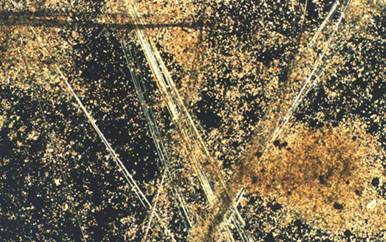What is Asbestos
What is Asbestos?
Asbestos is commonly found in many building materials and household items. Asbestos is a commercial term applied to the asbestiform varieties of six different minerals (See below).The properties of asbestos that caused it to be widely used commercially are:
- The ability to be separated into long, thin, flexible fibers
- High tensile strength
- Low thermal and electrical conductivity
- High mechanical and chemical durability
- High heat resistance
The six regulated types of asbestos are:
- Chrysotile (serpentine)
- Amosite
- Crocidolite
- Tremolite
- Actinolite
- Anthophyllite
Chrysotile, Mg3 [Si2O5] (OH) 4, Serpentine Group
Serpentine is a polymorphous, magnesium-rich mineral typically found in rocks. Chrysotile fibers are formed by sheet like crystals that roll into tight tubes and may exhibit several forms. The fibers may be compared to fine threads or hairs. Chrysotile usually occurs in bundles. Curved, wavy and kinked shapes are common; some straight fibers and bundles may also occur. Chrysotile bundles usually separate into individual fibers which have split ends. Chrysotile is the most common type of asbestos in building materials. The most useful characteristics of chrysotile fibers are high tensile strength and resistance to extreme temperatures. The mineral has been widely used in fireproofing and as a binder. Its strong, flexible fibers have been woven into fireproof cloth. Chrysotile is also chemically resistant and has been used to make laboratory bench tops that prevent chemical stains.
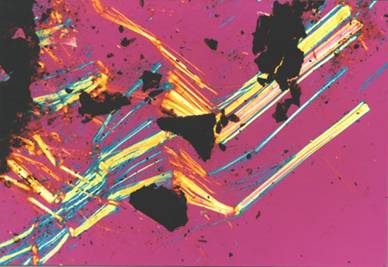
Chrysotile as seen under polarized light
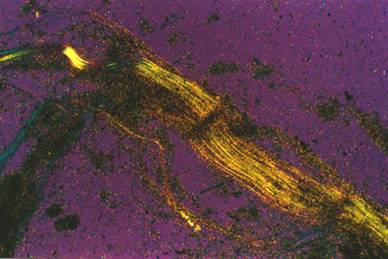
Chrysotile as seen under polarized light

Chrysotile as seen under polarized light
Amosite, (Fe2+, Mg) 7[Si8O22](OH) 2
Grunerite is the mineralogical correct name used for amphiboles of the cummingtonite-grunerite series in which iron is predominant over magnesium (70% or more Fe / [Fe+Mg]). The commercial asbestiform product used in building materials, commonly known as "amosite" (from the "Asbestos mines of South Africa") should thus be characterized as asbestiform grunerite. Amosite range in morphology from relatively thick flat prisms acicular brittle grains to very long thin fibers and fiber bundles. The long thin fibers are moderately brittle and often bend in wide arches. Bundles of amosite tend to separate into smaller groups of needlelike fibers. Because amosite fibers do not normally fray or have split ends, but rather have flat or knifelike ends, the needlelike morphology may help to distinguish this amphibole from chrysotile. Forms of bundles resembling "broom tails" are also common. Amosite is monoclinic and typically colored brown in plane light.
Amosite as seen under polarized light
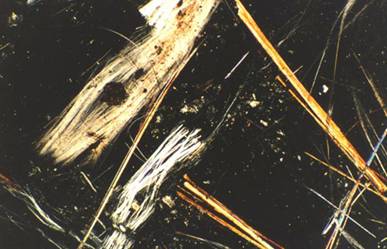
Amosite as seen under polarized lightCrocidolite, Na2Fe3+2 Fe2+3 [(Si8)22] (OH) 2
Crocidolite is the asbestiform variety of riebeckite. Riebeckite is the name used for minerals of the glaucophane-crossite-riebeckite series in which iron is predominant over magnesium and aluminum. Crocidolite is called the "Blue Asbestos", because it is strongly pleochroic, ranging from Prussian blue and indigo blue to yellow green. The characteristic form of crocidolite is similar to that of chrysotile. The fibers generally resemble strands of fine textured hair and are slightly more brittle than chrysotile, but can usually bend beyond 90° before breaking. Typically curved, hair like, but straight fibers and bundles may also be found. Crocidolite is harder than the other varieties of amphibole asbestos.
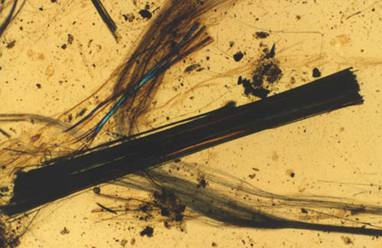
Crocidolite as seen under polarized light
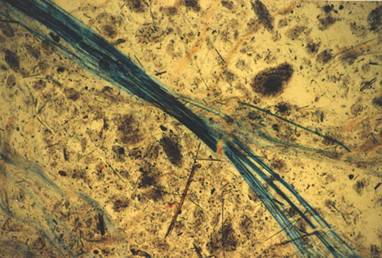
Crocidolite as seen under polarized light
Tremolite-Actinolite: Ca2 (Mg, Fe) 5 [Si822](OH) 2
Members of the tremolite-actinolite series are among the most common rock-forming minerals. They are frequently found as cleavage fragments in cements, plasters, roofing, and other building materials. Tremolite and actinolite may occur as contaminants in fillers, or as sand and gravel components of plasters or roofing materials. Tremolite and actinolite may also be associated with vermiculite, in vermiculite insulation samples. The division between tremolite and actinolite is defined by the relative amounts of magnesium and iron. The morphology of tremolite and actinolite ranges from prismatic or bladelike to acicular (needlelike). The blades are often pointed at both ends. Bundles commonly exhibit a radial arrangement.Anthophyllite (Mg, Fe) 7 [Si8O22} (OH) 2
Anthophyllite is the magnesian end-member of the orthorhombic anthophyllite-gedrite series. Most anthophyllite crystals are prismatic or acicular. However, truly fibrous (asbestiform) anthophyllite has been mined for centuries, notably in Finland and parts of the U.S. and Canada. This type of asbestos is rare in building materials. Fibers of anthophyllite appear to be extremely flat and thin. The characteristic shape resembles that of a knife blade, coming to a point at one end. Fibers from a particular sample tend to be relatively uniform in size. The parallel extinction of the mineral distinguishes it from tremolite or actinolite.
